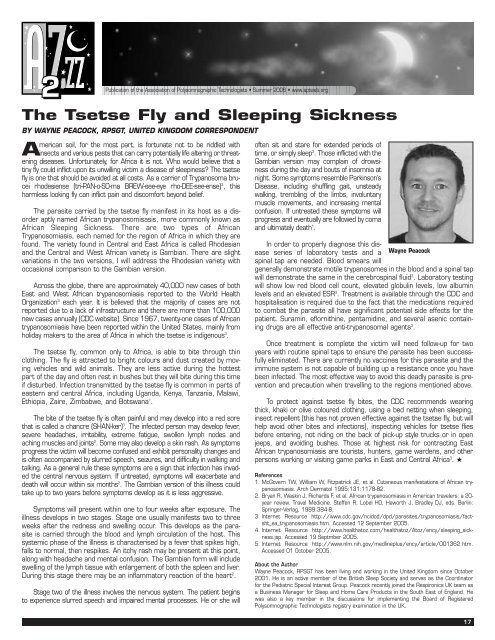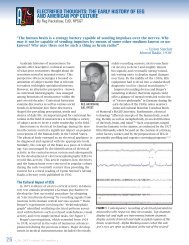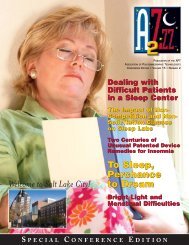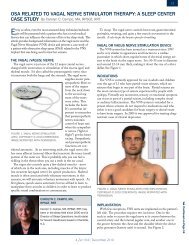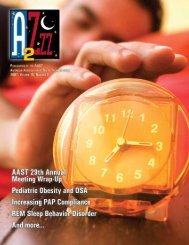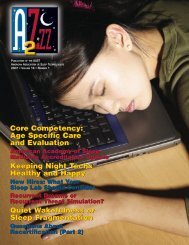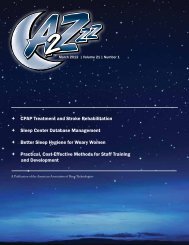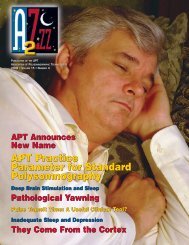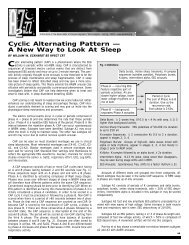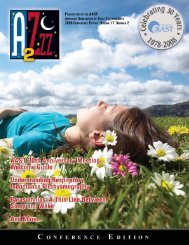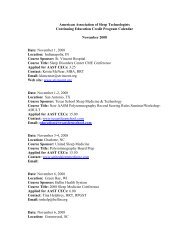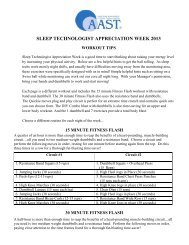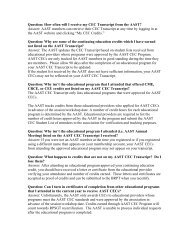Sleep - American Association of Sleep Technologists
Sleep - American Association of Sleep Technologists
Sleep - American Association of Sleep Technologists
Create successful ePaper yourself
Turn your PDF publications into a flip-book with our unique Google optimized e-Paper software.
Publication <strong>of</strong> the <strong>Association</strong> <strong>of</strong> Polysomnographic <strong>Technologists</strong> • Summer 2006 • www.aptweb.org<br />
The Tsetse Fly and <strong>Sleep</strong>ing Sickness<br />
BY WAYNE PEACOCK, RPSGT, UNITED KINGDOM CORRESPONDENT<br />
<strong>American</strong> soil, for the most part, is fortunate not to be riddled with<br />
insects and various pests that can carry potentially life altering or threatening<br />
diseases. Unfortunately, for Africa it is not. Who would believe that a<br />
tiny fly could inflict upon its unwilling victim a disease <strong>of</strong> sleepiness? The tsetse<br />
fly is one that should be avoided at all costs. As a carrier <strong>of</strong> Trypanosoma brucei<br />
rhodesiense (tri-PAN-o-SO-ma BREW-see-eye rho-DEE-see-ense) 3 , this<br />
harmless looking fly can inflict pain and discomfort beyond belief.<br />
The parasite carried by the tsetse fly manifest in its host as a disorder<br />
aptly named African trypanosomisasis, more commonly known as<br />
African <strong>Sleep</strong>ing Sickness. There are two types <strong>of</strong> African<br />
Trypanosomiasis, each named for the region <strong>of</strong> Africa in which they are<br />
found. The variety found in Central and East Africa is called Rhodesian<br />
and the Central and West African variety is Gambian. There are slight<br />
variations in the two versions, I will address the Rhodesian variety with<br />
occasional comparison to the Gambian version.<br />
Across the globe, there are approximately 40,000 new cases <strong>of</strong> both<br />
East and West African trypanosomiasis reported to the World Health<br />
Organization 3 each year. It is believed that the majority <strong>of</strong> cases are not<br />
reported due to a lack <strong>of</strong> infrastructure and there are more than 100,000<br />
new cases annually (CDC website). Since 1967, twenty-one cases <strong>of</strong> African<br />
trypanosomiasis have been reported within the United States, mainly from<br />
holiday makers to the area <strong>of</strong> Africa in which the tsetse is indigenous 3 .<br />
The tsetse fly, common only to Africa, is able to bite through thin<br />
clothing. The fly is attracted to bright colours and dust created by moving<br />
vehicles and wild animals. They are less active during the hottest<br />
part <strong>of</strong> the day and <strong>of</strong>ten rest in bushes but they will bite during this time<br />
if disturbed. Infection transmitted by the tsetse fly is common in parts <strong>of</strong><br />
eastern and central Africa, including Uganda, Kenya, Tanzania, Malawi,<br />
Ethiopia, Zaire, Zimbabwe, and Botswana 1 .<br />
The bite <strong>of</strong> the tsetse fly is <strong>of</strong>ten painful and may develop into a red sore<br />
that is called a chancre (SHAN-ker) 3 . The infected person may develop fever,<br />
severe headaches, irritability, extreme fatigue, swollen lymph nodes and<br />
aching muscles and joints 2 . Some may also develop a skin rash. As symptoms<br />
progress the victim will become confused and exhibit personality changes and<br />
is <strong>of</strong>ten accompanied by slurred speech, seizures, and difficulty in walking and<br />
talking. As a general rule these symptoms are a sign that infection has invaded<br />
the central nervous system. If untreated, symptoms will exacerbate and<br />
death will occur within six months 2 . The Gambian version <strong>of</strong> this illness could<br />
take up to two years before symptoms develop as it is less aggressive.<br />
Symptoms will present within one to four weeks after exposure. The<br />
illness develops in two stages. Stage one usually manifests two to three<br />
weeks after the redness and swelling occur. This develops as the parasite<br />
is carried through the blood and lymph circulation <strong>of</strong> the host. This<br />
systemic phase <strong>of</strong> the illness is characterised by a fever that spikes high,<br />
falls to normal, then respikes. An itchy rash may be present at this point,<br />
along with headache and mental confusion. The Gambian form will include<br />
swelling <strong>of</strong> the lymph tissue with enlargement <strong>of</strong> both the spleen and liver.<br />
During this stage there may be an inflammatory reaction <strong>of</strong> the heart 2 .<br />
Stage two <strong>of</strong> the illness involves the nervous system. The patient begins<br />
to experience slurred speech and impaired mental processes. He or she will<br />
<strong>of</strong>ten sit and stare for extended periods <strong>of</strong><br />
time, or simply sleep 3 . Those inflicted with the<br />
Gambian version may complain <strong>of</strong> drowsiness<br />
during the day and bouts <strong>of</strong> insomnia at<br />
night. Some symptoms resemble Parkinson’s<br />
Disease, including shuffling gait, unsteady<br />
walking, trembling <strong>of</strong> the limbs, involuntary<br />
muscle movements, and increasing mental<br />
confusion. If untreated these symptoms will<br />
progress and eventually are followed by coma<br />
and ultimately death 1 .<br />
In order to properly diagnose this disease<br />
series <strong>of</strong> laboratory tests and a Wayne Peacock<br />
spinal tap are needed. Blood smears will<br />
generally demonstrate motile trypanosomes in the blood and a spinal tap<br />
will demonstrate the same in the cerebrospinal fluid 3 . Laboratory testing<br />
will show low red blood cell count, elevated globulin levels, low albumin<br />
levels and an elevated ESR 3 . Treatment is available through the CDC and<br />
hospitalisation is required due to the fact that the medications required<br />
to combat the parasite all have significant potential side effects for the<br />
patient. Suramin, eflornithine, pentamidine, and several asenic containing<br />
drugs are all effective anti-trypanosomal agents 3 .<br />
Once treatment is complete the victim will need follow-up for two<br />
years with routine spinal taps to ensure the parasite has been successfully<br />
eliminated. There are currently no vaccines for this parasite and the<br />
immune system is not capable <strong>of</strong> building up a resistance once you have<br />
been infected. The most effective way to avoid this deadly parasite is prevention<br />
and precaution when travelling to the regions mentioned above.<br />
To protect against tsetse fly bites, the CDC recommends wearing<br />
thick, khaki or olive coloured clothing, using a bed netting when sleeping,<br />
insect repellent (this has not proven effective against the tsetse fly, but will<br />
help avoid other bites and infections), inspecting vehicles for tsetse flies<br />
before entering, not riding on the back <strong>of</strong> pick-up style trucks or in open<br />
jeeps, and avoiding bushes. Those at highest risk for contracting East<br />
African trypanosomiasis are tourists, hunters, game wardens, and other<br />
persons working or visiting game parks in East and Central Africa 3 . ★<br />
References<br />
1. McGovern TW, William W, Fitzpatrick JE, et al. Cutaneous manifestations <strong>of</strong> African trypanosomiasis.<br />
Arch Dermatol 1995;131:1178-82.<br />
2. Bryan R, Waskin J, Richards F, et al. African trypanosomiasis in <strong>American</strong> travelers: a 20-<br />
year review. Travel Medicine. Steffen R, Lobel HO, Haworth J, Bradley DJ, eds. Berlin:<br />
Springer-Verlag, 1989:384-8.<br />
3. Internet Resource http://www.cdc.gov/ncidod/dpd/parasites/trypanosomiasis/factsht_ea_trypanosomiasis.htm.<br />
Accessed 12 September 2005.<br />
4. Internet Resource http://www.healthatoz.com/healthatoz/Atoz/ency/sleeping_sickness.jsp.<br />
Accessed 19 Septmber 2005.<br />
5. Internet Resource http://www.nlm.nih.gov/medlineplus/ency/article/001362.htm.<br />
Accessed 01 October 2005.<br />
About the Author<br />
Wayne Peacock, RPSGT has been living and working in the United Kingdom since October<br />
2001. He is an active member <strong>of</strong> the British <strong>Sleep</strong> Society and serves as the Coordinator<br />
for the Pediatric Special Interest Group. Peacock recently joined the Respironics UK team as<br />
a Business Manager for <strong>Sleep</strong> and Home Care Products in the South East <strong>of</strong> England. He<br />
was also a key member in the discussions for implementing the Board <strong>of</strong> Registered<br />
Polysomnographic <strong>Technologists</strong> registry examination in the UK.<br />
17


